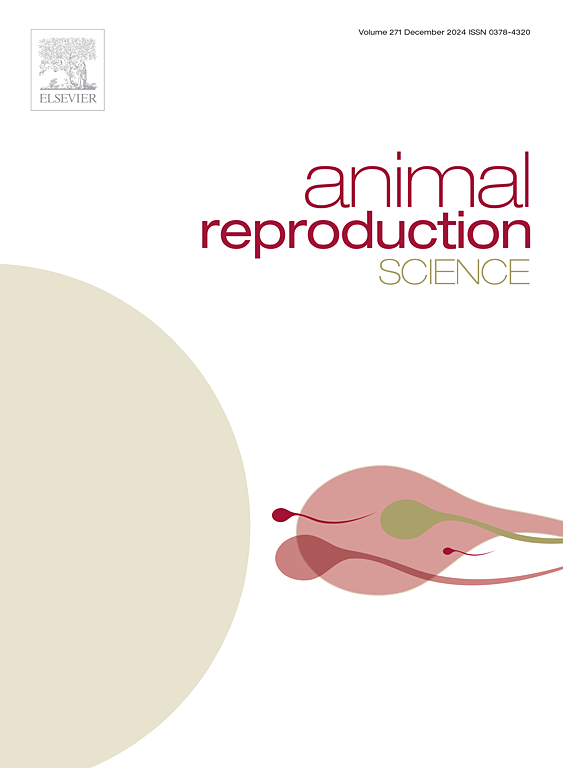一种新型的基于微流体的装置实现了牛积云细胞的自动去除和最佳胚胎发育
IF 3.3
2区 农林科学
Q1 AGRICULTURE, DAIRY & ANIMAL SCIENCE
引用次数: 0
摘要
卵母细胞或受精卵剥落是对卵母细胞或发育中的胚胎进行最佳可视化所必需的程序。积云细胞通常是通过机械和/或酶处理去除的,这是一个人工过程,在剥蚀的完整性和施加的剪切力方面,操作员之间容易发生变化。我们已经开发了一种基于微流体的自动剥离原型,能够一次剥离16个牛积云卵母细胞复合物(COCs)。将体外成熟受精的COCs随机分为两组,一组采用人工剥脱,另一组采用自动剥脱原型。透明带渗透性测试发现,无论采用何种剥蚀方案,透明带对20 nm的颗粒都具有渗透性,对40和100 nm的颗粒则不具有渗透性。两种方法的囊胚形成率相似,囊胚期囊胚细胞总数、内细胞质量和滋养外胚层细胞数量均无差异。两组胚泡转录组差异显著,仅有3个基因表达差异。相比之下,自动剥脱和人工剥脱后,体内胚泡与体外胚泡之间分别有36个和48个基因差异表达。最后,对孵化后发育能力的体外分析显示,人工或自动剥落后获得的胚胎的存活率、下胚层迁移率和胚胎盘形成率相似。总之,该装置可能是一种安全且可重复的方法来剥离牛COCs,并且是在人类COCs中实现自动剥离的第一步,其大小与牛的COCs非常相似。本文章由计算机程序翻译,如有差异,请以英文原文为准。
A novel microfluidics-based device achieves automatic cumulus cells removal and optimal embryo development in cattle
Oocyte or zygote denudation is a procedure required for optimal visualization of the oocyte or the developing embryo. Cumulus cells are conventionally removed by mechanical and/or enzymatic treatment, a manual procedure prone to operator-to-operator variations in completeness of denudation and shear force applied. We have developed an automated denudation prototype based on microfluidics able to denude 16 bovine cumulus oocyte complexes (COCs) at a time. COCs matured and fertilized in vitro were randomly allocated into two groups: one was denuded by manual stripping and other was denuded using the automatic denudation prototype. A zona pellucida permeability test observed that zonae were permeable to 20 nm particles and impermeable to 40 and 100 nm, irrespective of the denudation protocol employed. Blastocyst formation rates were similar between both protocols, and no differences were observed in the total, inner cell mass and trophectoderm cell numbers at the blastocyst stage. Blastocyst transcriptome was remarkably similar between both denudation groups, with only three genes being differentially expressed. In contrast, 36 and 48 genes were differentially expressed between in vivo derived blastocysts and in vitro produced blastocysts following automatic and manual denudation, respectively. Finally, an in vitro analysis of post-hatching developmental ability revealed similar survival, hypoblast migration and embryonic disc formation rates between embryos obtained following manual or automatic denudation. In conclusion, the device possibilities a safe and repeatable means to denude bovine COCs and constitutes a first step to attain automatic denudation in human COCs, whose size is remarkably similar to those of cattle.
求助全文
通过发布文献求助,成功后即可免费获取论文全文。
去求助
来源期刊

Animal Reproduction Science
农林科学-奶制品与动物科学
CiteScore
4.50
自引率
9.10%
发文量
136
审稿时长
54 days
期刊介绍:
Animal Reproduction Science publishes results from studies relating to reproduction and fertility in animals. This includes both fundamental research and applied studies, including management practices that increase our understanding of the biology and manipulation of reproduction. Manuscripts should go into depth in the mechanisms involved in the research reported, rather than a give a mere description of findings. The focus is on animals that are useful to humans including food- and fibre-producing; companion/recreational; captive; and endangered species including zoo animals, but excluding laboratory animals unless the results of the study provide new information that impacts the basic understanding of the biology or manipulation of reproduction.
The journal''s scope includes the study of reproductive physiology and endocrinology, reproductive cycles, natural and artificial control of reproduction, preservation and use of gametes and embryos, pregnancy and parturition, infertility and sterility, diagnostic and therapeutic techniques.
The Editorial Board of Animal Reproduction Science has decided not to publish papers in which there is an exclusive examination of the in vitro development of oocytes and embryos; however, there will be consideration of papers that include in vitro studies where the source of the oocytes and/or development of the embryos beyond the blastocyst stage is part of the experimental design.
 求助内容:
求助内容: 应助结果提醒方式:
应助结果提醒方式:


